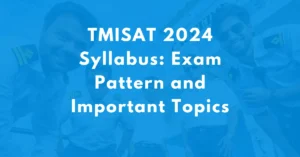(IMU CET) stands for Indian Maritime University Common Entrance Test and it is one of the most important stages in becoming a seafarer. This is a compulsory examination that aspiring university undergraduates and postgraduates have to take at IMU. It’s crucial to know about IMU CET, its syllabus, exam dates and other crucial details if you are thinking of working as a seaman. In this article we will dive into some specifics of IMU CET.
Understanding IMU CET Exam:
The Indian Maritime University Common Entrance Test (IMU CET) is an entrance examination conducted by the Indian Maritime University (IMU), Chennai. IMU, a central university established under the Ministry of Ports, Shipping and Waterways, Government of India. IMU CET remains the chief method of selecting candidates for admission into various maritime courses offered by IMU and its affiliated institutes throughout the nation.
| Particulars | Details |
| Mode of Examination | Computer-Based Exam |
| Duration | 3 Hours |
| Medium of Exam | English |
| Type of Questions | Multiple Choice Questions (MCQs) |
| Section-wise Distribution of Questions | English – 25 QuestionsGeneral Knowledge – 25 QuestionsGeneral Aptitude – 25 QuestionsChemistry – 25 QuestionsMathematics – 50 QuestionsPhysics – 50 Questions |
| IMU CET Total Marks | 200 Marks |
| Total Number of Questions | 200 Questions |
| Marking Scheme | 0.25 marks will be deducted for every wrong answer |
Syllabus Overview:
To sail smoothly through IMU CET, it’s imperative to have a thorough understanding of its syllabus. The syllabus primarily comprises subjects related to maritime studies, mathematics, physics, chemistry, English, general knowledge, and reasoning ability. Here’s a brief overview of the syllabus:
- Mathematics: Algebra, Trigonometry, Geometry, Differential Calculus, Integral Calculus, Differential Equations, Vectors, Probability, and Statistics.
- Physics: Laws of Motion, Work, Energy, and Power, Properties of Matter, Electrostatics, Current Electricity, Magnetic Effect of Current and Magnetism, Electromagnetic Induction and Alternating Current, Optics, Dual Nature of Radiation and Atomic Physics.
- Chemistry: Some Basic Concepts of Chemistry, Structure of Atom, Classification of Elements and Periodicity in Properties, Chemical Bonding and Molecular Structure, States of Matter: Gases and Liquids, Thermodynamics, Equilibrium, Redox Reactions, Hydrogen, s-Block Elements, p-Block Elements, Organic Chemistry: Some Basic Principles and Techniques, Hydrocarbons, Environmental Chemistry.
- English: Vocabulary, Grammar, Reading Comprehension, Verbal Reasoning.
- General Knowledge: Current Affairs (National and International), Major Ports of India, Famous Personalities in the Maritime Industry, History, Geography, Economics, Politics, etc.
- Reasoning Ability: Verbal and Non-Verbal Reasoning, Logical Deduction.
IMU CET 2024 Syllabus for Physics
Candidates can check the IMU CET Syllabus PDF for Physics.
| Units | Chapters |
| Electrostatics | Electric Charges and Fields |
| Electrostatic Potential and Capacitance | |
| Current Electricity | Current Electricity |
| Magnetic Effects of Current and Magnetism | Moving Charges and Magnetism |
| Magnetism and Matter | |
| Electromagnetic Induction and Alternating Currents | Electromagnetic Induction |
| Alternating Current | |
| Electromagnetic Waves | Electromagnetic Waves |
| Optics | Ray Optics and Optical Instruments |
| Wave Optics | |
| Dual Nature of Radiation and Matter | Dual Nature of Radiation and Matter |
| Atoms and Nuclei | Atoms |
| Nuclei | |
| Electronic Devices | Semiconductor Electronics: Materials, Devices and Simple Circuits |
IMU CET 2024 Syllabus for Chemistry
Candidates can access the IMU CET Syllabus PDF to review the topics covered in Chemistry.
| Units | Chapters |
| Solutions | Types of solutions, expression of concentration of solutions of solids in liquids, solubility of gases in liquids, solid solutions, colligative properties – relative lowering of vapour pressure, Raoult’s law, elevation of boiling point, depression of freezing point, osmotic pressure, determination of molecular masses using colligative properties, abnormal molecular mass, Van’t Hoff factor. |
| Electrochemistry | Redox reactions, conductance in electrolytic solutions, specific and molar conductivity, variations of conductivity with concentration, Kohlrausch’s Law, electrolysis and law of electrolysis (elementary idea), dry cell-electrolytic cells and Galvanic cells, lead accumulator, EMF of a cell, standard electrode potential, Nernst equation and its application to chemical cells, Relation between Gibbs energy change and EMF of a cell, fuel cells, corrosion. |
Chemical Kinetics |
Rate of a reaction (Average and instantaneous), factors affecting rate of reaction: concentration, temperature, catalyst; order and molecularity of a reaction, rate law and specific rate constant, integrated rate equations and half-life (only for zero and first order reactions), concept of collision theory (elementary idea, no mathematical treatment). Activation energy, Arrhenius equation. |
| Surface Chemistry | Adsorption – physisorption and chemisorption, factors affecting adsorption of gases on solids, catalysis, homogenous and heterogenous activity and selectivity; enzyme catalysis colloidal state distinction between true solutions, colloids and suspension; lyophilic, lyophobic multi-molecular and macromolecular colloids; properties of colloids; Tyndall effect, Brownian movement, electrophoresis, coagulation, emulsion – types of emulsions. |
| General Principles and Processes of Isolation of Elements | Principles and methods of extraction – concentration, oxidation, reduction – electrolytic method and refining; occurrence and principles of extraction of aluminum, copper, zinc and iron |
| p – Block Elements | Group 16 Elements: General introduction, electronic configuration, oxidation states, occurrence, trends in physical and chemical properties, dioxygen: Preparation, Properties and uses, classification of Oxides, Ozone, Sulphur – allotropic forms; compounds of Sulphur: Preparation Properties and uses of Sulphur-dioxide, Sulphuric Acid: industrial process of manufacture, properties and uses; Oxoacids of Sulphur (Structures only).Group 17 Elements: General introduction, electronic configuration, oxidation states, occurrence, trends in physical and chemical properties; compounds of halogens, Preparation, properties and uses of Chlorine and Hydrochloric acid, interhalogen compounds, Oxoacids of halogens (structures only).Group 18 Elements: General introduction, electronic configuration, occurrence, trends in physical and chemical properties, uses. |
| ‘d’ and ‘f’ Block Elements | General introduction, electronic configuration, occurrence and characteristics of transition metals, general trends in properties of the first row transition metals – metallic character, ionization enthalpy, oxidation states, ionic radii, colour, catalytic property, magnetic properties, interstitial compounds, alloy formation, preparation and properties of K2Cr2O7 and KMnO4.Lanthanoids – Electronic configuration, oxidation states, chemical reactivity and lanthanoid contraction and its consequences.Actinoids – Electronic configuration, oxidation states and comparison with lanthanoids. |
| Coordination Compounds | Coordination compounds – Introduction, ligands, coordination number, colour, magnetic properties and shapes, IUPAC nomenclature of mononuclear coordination compounds. Bonding, Werner’s theory, VBT, and CFT; structure and stereoisomerism, importance of coordination compounds (in qualitative inclusion, extraction of metals and biological system). |
| Haloalkanes and Haloarenes | Haloalkanes: Nomenclature, nature of C-X bond, physical and chemical properties, mechanism of substitution reactions, optical rotation. Haloarenes: Nature of C-X bond, substitution reactions (Directive influence of halogen in monosubstituted compounds only).Uses and environmental effects of – dichloromethane, trichloromethane, tetrachloromethane, iodoform, freons, DDT. |
| Alcohols, Phenols and Ethers | Alcohols: Nomenclature, methods of preparation, physical and chemical properties (of primary alcohols only), identification of primary, secondary and tertiary alcohols, mechanism of dehydration, uses with special reference to methanol and ethanol.Phenols: Nomenclature, methods of preparation, physical and chemical properties, acidic nature of phenol, electrophillic substitution reactions, uses of phenols.Ethers: Nomenclature, methods of preparation, physical and chemical properties, uses. |
| Aldehydes, Ketones and Carboxylic Acids | Aldehydes and Ketones: Nomenclature, nature of carbonyl group, methods of preparation, physical and chemical properties, mechanism of nucleophilic addition, reactivity of alpha hydrogen in aldehydes, uses.Carboxylic Acids: Nomenclature, acidic nature, methods of preparation, physical and chemical properties; uses. |
| Organic compounds containing Nitrogen | Amines: Nomenclature, classification, structure, methods of preparation, physical and chemical properties, uses, identification of primary, secondary and tertiary amines.Cyanides and Isocyanides – will be mentioned at relevant places in text.Diazonium salts: Preparation, chemical reactions and importance in synthetic organic chemistry |
| Biomolecules | Carbohydrates – Classification (aldoses and ketoses), monosaccahrides (glucose and fructose), D-L configuration oligosaccharides (sucrose, lactose, maltose), polysaccharides (starch, cellulose, glycogen); Importance of carbohydrates.Proteins -Elementary idea of – amino acids, peptide bond, polypeptides, proteins, structure of proteins – primary, secondary, tertiary structure and quaternary structures (qualitative idea only), denaturation of proteins; enzymes. Hormones – Elementary idea excluding structure.Vitamins – Classification and functions.Nucleic Acids: DNA and RNA |
| Polymers | Copolymerization, some important polymers: natural and synthetic like polythene, nylon polyesters, Bakelite, rubber. Biodegradable and non-biodegradable polymers |
| Chemistry in Everyday life | Chemicals in medicines – analgesics, tranquilizers antiseptics, disinfectants, antimicrobials, antifertility drugs, antibiotics, antacids, antihistamines.Chemicals in food – preservatives, artificial sweetening agents, elementary idea of antioxidants.Cleansing agents- soaps and detergents, cleansing action. |
IMU CET 2024 Syllabus for Maths
Candidates can refer to the IMU CET exam Syllabus PDF to find the detailed curriculum for Mathematics.
| Units | Topics |
| Relations and Functions | Types of relations: reflexive, symmetric, transitive and equivalence relations. One-to-one and onto functions, composite functions, the inverse of a function. |
| Inverse Trigonometric Functions | Definition, range, domain, principal value branch. Graphs of inverse trigonometric functions. Elementary properties of inverse trigonometric functions. |
| Matrices | Concept, notation, order, equality, types of matrices, zero and identity matrix, transpose of a matrix, symmetric and skew-symmetric matrices.Operation on matrices: Addition and multiplication and multiplication with a scalar. Simple properties of addition, multiplication and scalar multiplication. Non- commutativity of multiplication of matrices and existence of non-zero matrices whose product is the zero matrix (restrict to square matrices of order 2).Concept of elementary row and column operations. Invertible matrices and proof of the uniqueness of inverse, if it exists; (Here all matrices will have real entries). |
| Determinants | Determinant of a square matrix (up to 3 x 3 matrices), properties of determinants, minors, co-factors and applications of determinants in finding the area of a triangle. Adjoint and inverse of a square matrix. Consistency, inconsistency and number of solutions of system of linear equations by examples, solving system of linear equations in two or three variables (having unique solution) using inverse of a matrix. |
| Continuity and Differentiability | Continuity and differentiability, derivative of composite functions, chain rule, derivative of inverse trigonometric functions, derivative of implicit functions. Concept of exponential and logarithmic functions.Derivatives of logarithmic and exponential functions. Logarithmic differentiation, a derivative of functions expressed in parametric forms. Second-order derivatives. Rolle’s and Lagrange’s Mean Value Theorems (without proof) and their geometric interpretation. |
| Applications of Derivatives | Applications of derivatives: rate of change of bodies, increasing/decreasing functions, tangents and normals, use of derivatives in approximation, maxima and minima (first derivative test motivated geometrically and second derivative test given as a provable tool). Simple problems (that illustrate basic principles and understanding of the subject as well as real-life situations). |
| Integrals | Integration as the inverse process of differentiation. Integration of a variety of functions by substitution, by partial fractions and by parts, Evaluation of simple integrals of the following types and problems based on them.Definite integrals as a limit of a sum, Fundamental Theorem of Calculus (without proof).Basic properties of definite integrals and evaluation of definite integrals. |
| Applications of the Integrals | Applications in finding the area under simple curves, especially lines, circles/ parabolas/ellipses (in standard form only), Area between any of the two above said curves (the region should be clearly identifiable). |
| Differential Equations | Definition, order and degree, general and particular solutions of a differential equation. Formation of differential equation whose general solution is given. Solution of differential equations by method of separation of variables, solutions of homogeneous differential equations of first order and first degree. Solutions of linear differential equation of the type: Dy/dx + py = q, where p and q are functions of x or constants.D?/d? + px = q, where p and q are functions of y or constants. |
| Vectors | Vectors and scalars, magnitude and direction of a vector. Direction cosines and direction ratios of a vector. Types of vectors (equal, unit, zero, parallel and collinear vectors), position vector of a point, negative of a vector, components of a vector, addition of vectors, multiplication of a vector by a scalar, position vector of a point dividing a line segment in a given ratio. Definition, Geometrical Interpretation, properties and application of scalar (dot) product of vectors, vector (cross) product of vectors, scalar triple product of vectors. |
| Three – dimensional Geometry | Direction cosines and direction ratios of a line joining two points. Cartesian equation and vector equation of a line, coplanar and skew lines, shortest distance between two lines. Cartesian and vector equation of a plane. Angle between (i) two lines, (ii) two planes, (iii) a line and a plane. Distance of a point from a plane. |
| Linear Programming | Introduction, related terminology such as constraints, objective function, optimization, different types of linear programming (L.P.) problems, mathematical formulation of L.P. problems, graphical method of solution for problems in two variables, feasible and infeasible regions (bounded or unbounded), feasible and infeasible solutions, optimal feasible solutions (up to three non-trivial constraints). |
| Probability | Conditional probability, multiplication theorem on probability, independent events, total probability, Bayes’ theorem, Random variable and its probability distribution, mean and variance of random variable. |
IMU CET 2024 Syllabus for General Knowledge
| General Knowledge | Basic GK Questions and Current Affairs |
| Logical Reasoning | Critical Reasoning Word Groups Instructions Structural Analysis Syllogism (Logic Syllogism (Logic based questions) Fill in/Completion of series based on Pattern/Logic, Data Sufficiency Data Interpretation Pipes & Cisterns Odd Man Out Boat & Streams Numerical Computation Numerical Estimation Time & Work Calendar Clocks Stocks Time & Distance Height & Distance Quantitative Aptitude Analytical Reasoning Logic Reasoning Fault Diagnosis Abstract Reasoning Mechanical Reasoning Mixture & Allegation Ratio Numerical Reasoning |
IMU CET 2024 Syllabus for English
| English | Synonyms and Antonyms Parts of Speech Meaning of words/phrases Tenses Phrasal verbs Idioms |
Exam Dates and Forms:
IMU CET is usually conducted once a year, typically in the month of June. However, it’s essential to stay updated with the official notification released by the Indian Maritime University for precise exam dates. As for the application forms, they are generally made available online on the official website of IMU a few months before the exam date. Candidates are required to fill out the application forms accurately and submit them within the specified deadline along with the requisite application fee.
Preparation Strategy:
Preparing for IMU CET requires dedication, perseverance, and a well-structured study plan. Here are some tips to help you prepare effectively:
- Understand the Syllabus: Familiarize yourself with the syllabus and exam pattern to strategize your preparation accordingly.
- Time Management: Allocate sufficient time to cover each subject thoroughly while giving more attention to areas of weakness.
- Practice Regularly: Practice previous years’ question papers and take mock tests to gauge your preparation level and improve your speed and accuracy.
- Refer to Quality Study Material: Utilize standard textbooks and study materials recommended for IMUCET preparation to ensure comprehensive coverage of topics.
- Stay Updated: Keep yourself updated with current affairs, especially those related to the maritime industry, to ace the general knowledge section.
Conclusion
IMU CET is a gateway to a fulfilling career at sea. To navigate this exam successfully, equip yourself with the knowledge provided in this guide. Delve into the syllabus, exam schedule, and preparation tips to prepare meticulously. Your dedication and determination will be the guiding light toward achieving your maritime dreams. Let the winds of fortune propel you on your IMU CET adventure!
To Download the syllabus of IMUCET 2024 Visit the official website of the Indian Maritime University (IMU). The website URL is usually www.imu.edu.in.
The IMU CET 2024 exam will have 200 questions and the distribution of questions is as follows:
-
English – 25 Questions
-
General Knowledge – 25 Questions
-
General Aptitude – 25 Questions
-
Chemistry – 25 Questions
-
Mathematics – 50 Questions
-
Physics – 50 Questions.
IMU will announce the date IMU CET 2024 exam date. Mostly It happens in the month of June.
In the IMU CET exam, there is a provision for negative marking. For each incorrect answer, 0.25 marks will be deducted from the total score.





